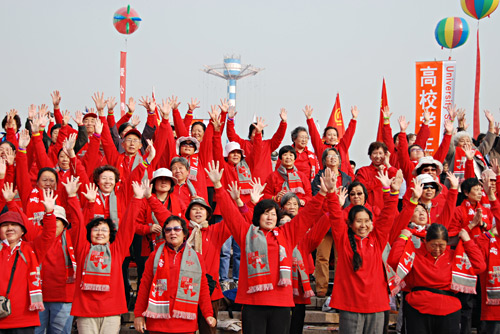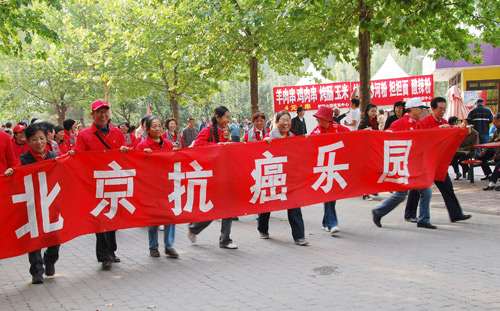|
 |
|
Participants do warm-up exercises before the start of the 11th Beijing Hope Run (CHEN RAN) |
At 9 a.m. on October 24 at Beijing's Chaoyang Park, Yang Panyi, 22, put on his grey rollerblades and began warm-up exercises with his friends near the starting point of the 11th Beijing Hope Run at Lihua Square.
"This is my first time to join the run," the amateur marathoner from Peking Union Medical College told Beijing Review. "I'm excited to see thousands of participants from home and abroad come here to show their support for the anti-cancer campaign."
The origin of the Beijing Hope Run is the Terry Fox Run, the largest one-day cancer fundraiser in the world. The Terry Fox Run honors Terry Fox, a Canadian bone cancer patient who ran 5,373 km across Canada in 143 days in 1980 to raise funds for cancer research.
Since the Beijing Hope Run was first held in September 1999, the Cancer Institute and Hospital under the Chinese Academy of Medical Sciences (CIH) has been its principal organizer in cooperation with the Canadian Embassy in China.
 |
|
Members of Beijing Anti-Cancer Club, who used to suffer from cancers, join the 11th Beijing Hope Run (CHEN RAN) |
This year's run began at 10 a.m. and ended at 3 p.m., with a distance of approximately 8 km; the theme was "Love Passes Hope of Life." Nearly 100 corporations and organizations had donated more than one million yuan ($147,000) before the run started.
A charity project called "Health Theme Park" was held parallel with the run, providing cancer prevention information through lectures, brochures and boards.
Li Manqin, a retired teacher, told Beijing Review that the Health Theme Park offered a broader view on cancer prevention, which was "helpful and should be continued in the future."
According to Zhao Ping, President of CIH, more than 200,000 people have taken part in the run since 1999. The event has raised more than 5 million yuan (approximately $733,000) for ongoing cancer research in China, including cervical cancer research in the poor and remote areas of Shanxi Province, the Taihang Anti-Cancer Project which covers a population of over 600,000, and epidemiological research on malignant tumors in Tibet Autonomous Region.
"This serious endeavor will continue as best as we can," Zhao said. | 